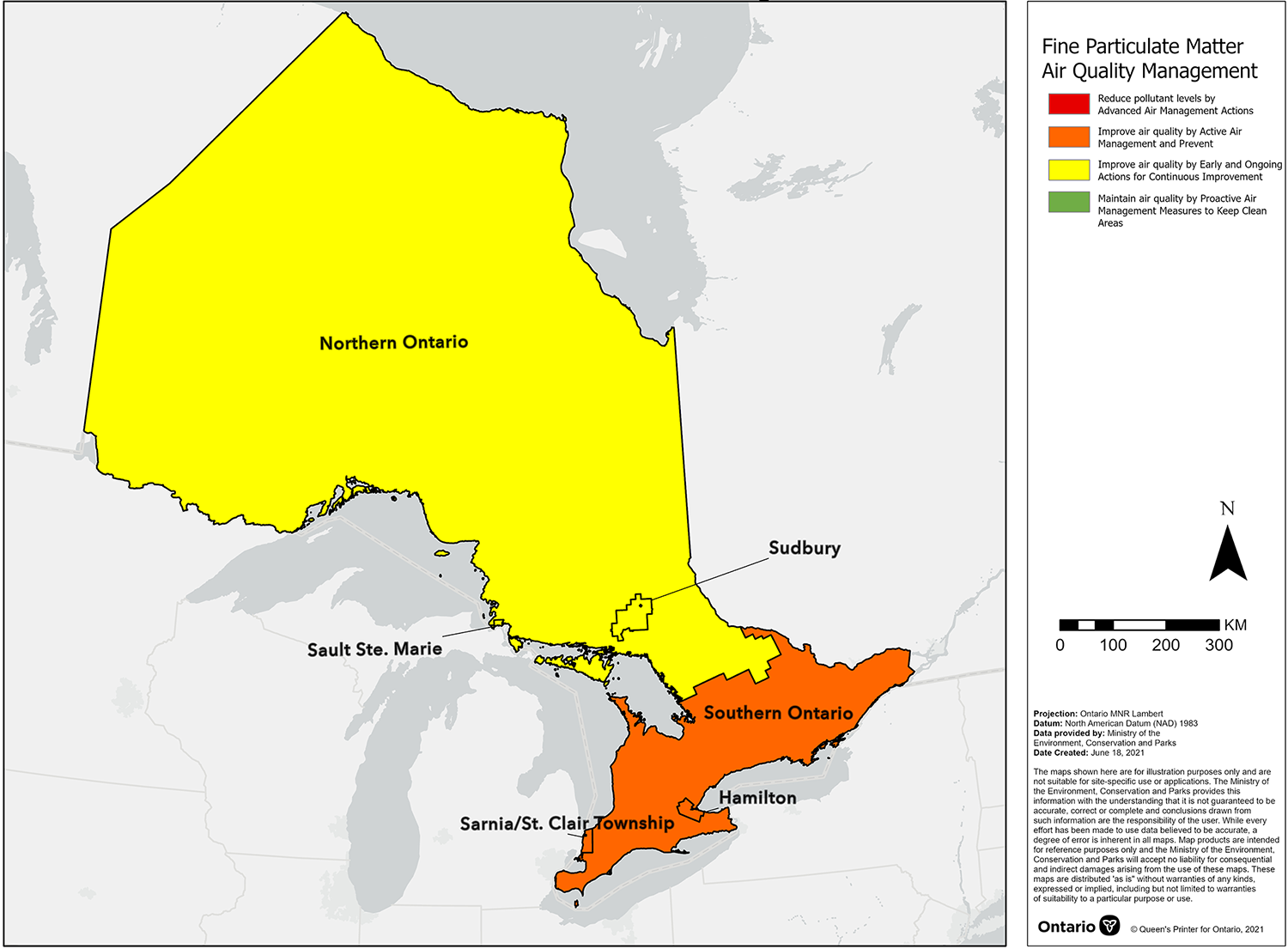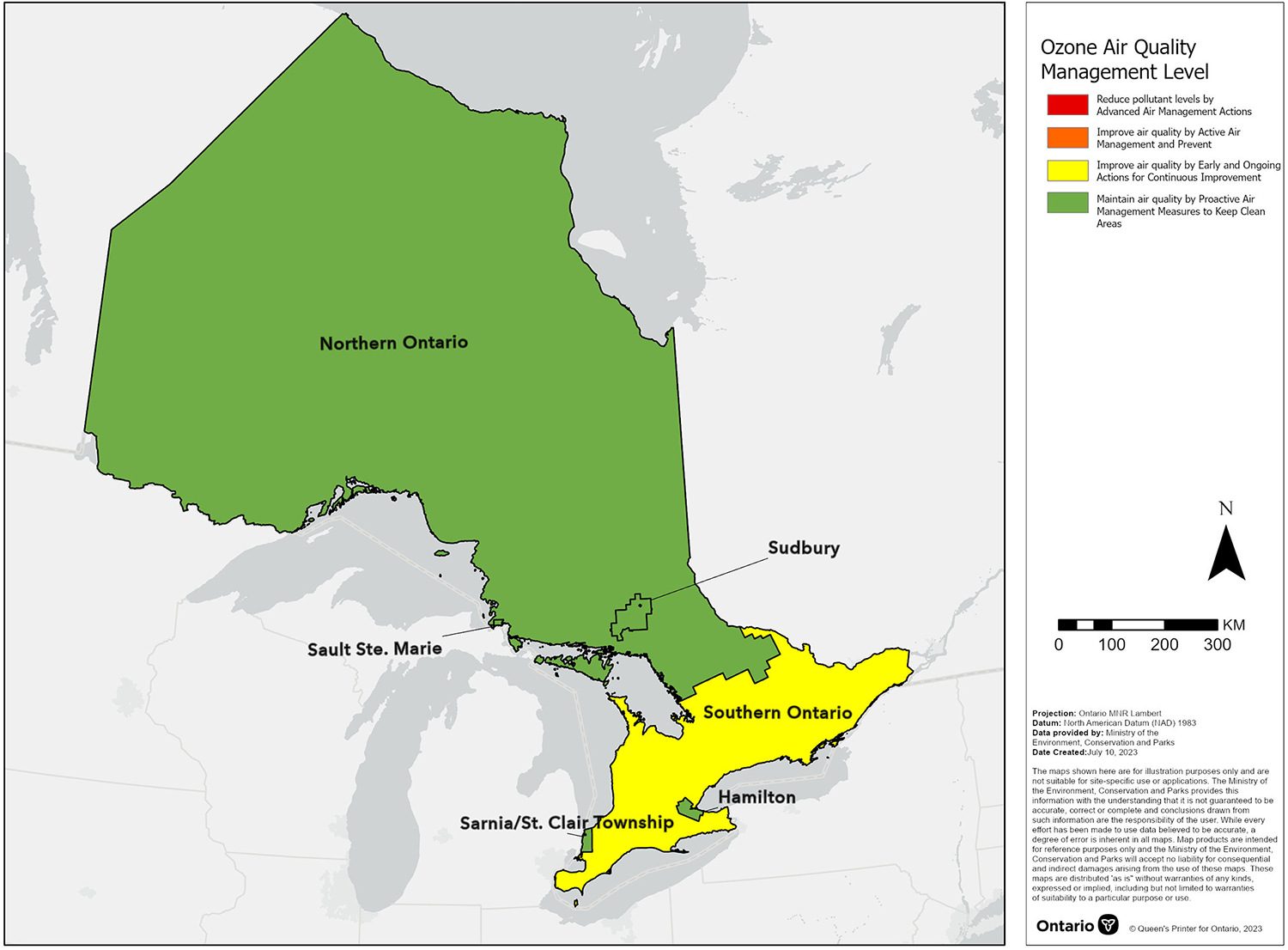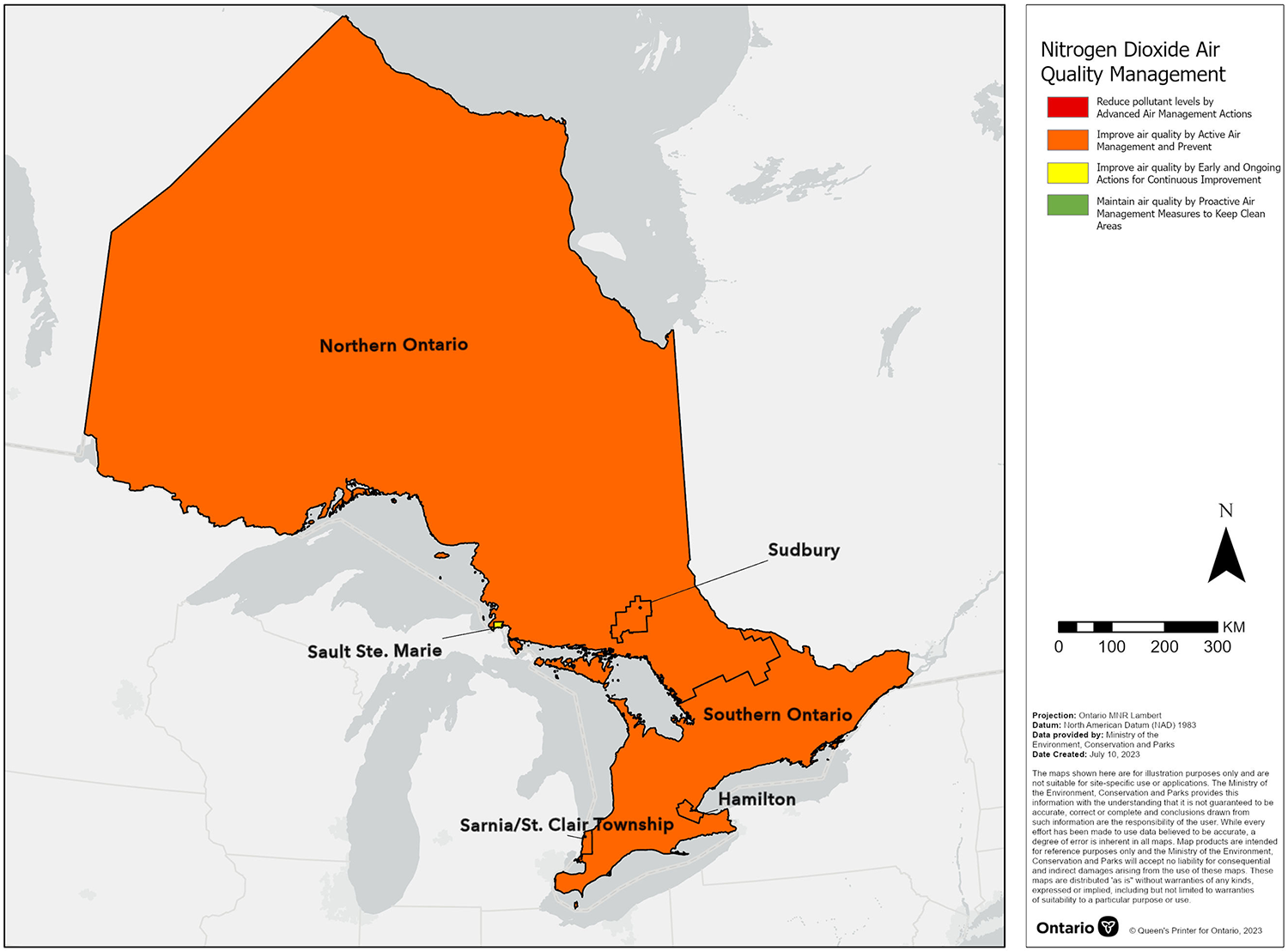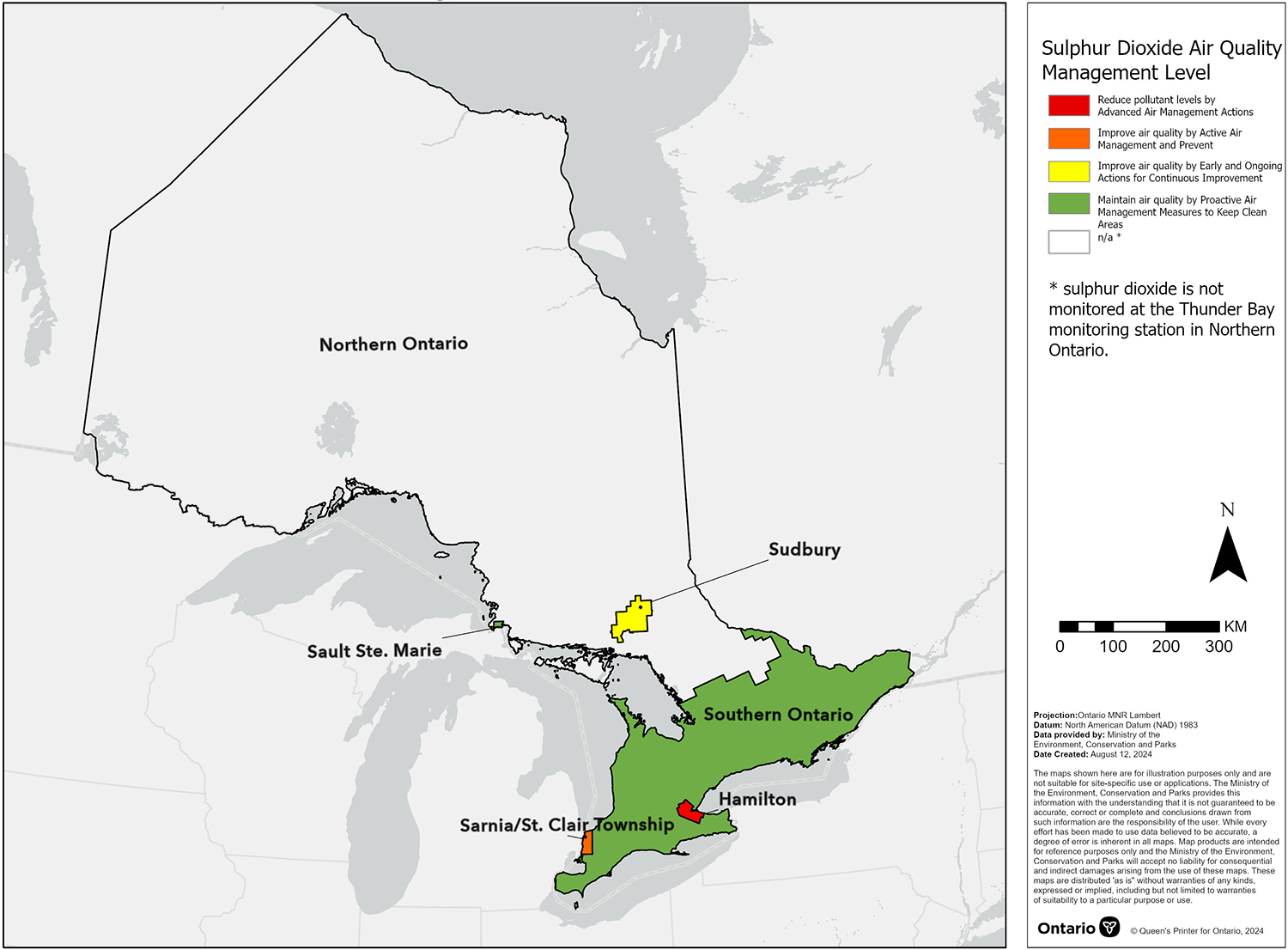National Air Quality Management System
The national Air Quality Management System (AQMS) is a collaborative approach for reducing air pollution in Canada. It consists of several elements:
- Canadian Ambient Air Quality Standards: non-regulatory health and environmental-based air quality objectives intended to drive improvements where needed.
- air zone management framework: management approach builds around air zone areas delineated within a province or territory.
- regional airsheds: six regional airsheds cover all of Canada and allow for coordination and joint action in resolving issues across provincial/territorial boundaries and international borders.
- base-level industrial emissions requirements: intended to ensure that all significant industrial sources in Canada, regardless of where facilities are located, meet base-level performance standards.
- addressing mobile emission sources: builds on the existing range of federal, provincial and territorial initiatives aimed at reducing emissions from the transportation sector.
Canadian Ambient Air Quality Standards
The Canadian Council of Ministers of the Environment have developed Canadian Ambient Air Quality Standards (CAAQS) as a key element of the Air Quality Management System to drive improvement of air quality across Canada. CAAQS are non-regulatory ambient air objectives that are used to assess general air quality and reflect desirable concentrations of contaminants in air from all sources. CAAQS have been developed for fine particulate matter, ozone, nitrogen dioxide and sulphur dioxide.
| Pollutant | Averaging time | Numerical value 2015 | Numerical value 2020 | Numerical value 2025 | Statistical form |
|---|---|---|---|---|---|
| Fine particulate matter (PM2.5) | 24-hour | 28 μg/m3 | 27 μg/m3 | N/A | The 3-year average of the annual 98th percentile of the PM2.5 daily 24-hour average concentrations |
| Fine particulate matter (PM2.5) | Annual | 10.0 μg/m3 | 8.8 μg/m3 | N/A | The 3-year average of the annual average of the PM2.5 daily 24-hour average concentrations |
| Ozone (O3) | 8-hour | 63 ppb | 62 ppb | 60 ppb | The 3-year average of the annual 4th highest of the daily maximum 8-hour average ozone concentrations |
| Nitrogen dioxide (NO2) | 1-hour | N/A | 60 ppb | 42 ppb | The 3-year average of the annual 98th percentile of the NO2 daily maximum 1-hour average concentrations |
| Nitrogen dioxide (NO2) | Annual | N/A | 17 ppb | 12 ppb | The average over a single calendar year of all NO2 1-hour average concentrations |
| Sulphur dioxide (SO2) | 1-hour | N/A | 70 ppb | 65 ppb | The 3-year average of the annual 99th percentile of the SO2 daily maximum 1-hour average concentrations |
| Sulphur dioxide (SO2) | Annual | N/A | 5.0 ppb | 4.0 ppb | The average over a single calendar year of all 1-hour average SO2 concentrations |
Source: Canadian Council of Ministers of the Environment
Air zone management framework
- The air zone management framework (AZMF) is a place-based approach to managing air quality under the AQMS.
- The framework provides guidance on management, monitoring and reporting actions to be implemented in an area to achieve the CAAQS.
- Under the AQMS, each jurisdiction is required to:
- delineate air zones to cover their entire jurisdiction
- publicly report on monitored levels of the CAAQS pollutants in their air zones
- identify management actions to improve air quality in their air zones
Air zones – Managing air quality in Ontario
As part of its implementation of the federal AQMS, Ontario has identified six geographic air zones falling into one of three air zone categories. These air zone designations are based on factors such as pollutant sources, topography, meteorological patterns, population density and other factors that potentially influence ambient air concentrations.
| Air zone categories | Air zone areas |
|---|---|
| Category 1 Areas with limited pollution from either point or non-point sources or transboundary influence | Northern Ontario (except for Sudbury and Sault Ste. Marie) |
| Category 2 Areas under pressure from multiple sources including some or all of the following: non-point sources, smaller point sources, individual large industrial point sources, transboundary influences | Southern Ontario (except for Sarnia/St. Clair Township and Hamilton) Sault Ste. Marie Sudbury |
| Category 3 Areas with a concentration of large industrial sources | Sarnia/St. Clair Township Hamilton |
Ontario has designated 27 AQHI ambient air monitoring stations located across all of the province’s air zones as CAAQS reporting stations. These 27 designated stations report for each of the CAAQS parameters, except for SO2 which only has 9 CAAQS reporting stations. Designated sites normally refer to communities with populations greater than 100,000 and/or communities with large industrial emission sources.
CAAQS reporting stations in Ontario air zone categories and areas
This map presents the locations of the designated CAAQS reporting stations within the air zone areas of each air zone category in Ontario.
Air zone management levels and objectives
- Four “management levels” provide general guidance on the state of air quality in each air zone relative to the CAAQS.
- The four management levels are identified by specific colours: red, orange, yellow and green, each corresponding to a contaminant concentration range that is specific to each CAAQS.
- Each management level is associated with a suite of actions that become progressively more stringent as air pollution concentrations approach or exceed the CAAQS.
- The air zone management level is determined by the designated CAAQS reporting station(s) with the highest CAAQS metric within the air zone.
The air zone management framework
Progressively more rigorous actions as air pollutant concentrations approach or exceed the CAAQS.
| Management level | Objective |
|---|---|
| Red The highest level of air quality management | To reduce pollutant levels below the CAAQS through advanced air management actions |
| Orange The second highest level of air quality management | To improve air quality through active air management and prevent exceedance of the CAAQS |
| Yellow The second lowest level of air quality management | To improve air quality using early and ongoing actions for continuous improvement |
| Green The lowest level of air quality management | To maintain good air quality through proactive air management measures to keep clean areas clean |
The numeric concentration ranges for each management level for each CAAQS pollutant are presented in the Appendix: Management Levels for CAAQS Pollutants.
Air zone management
Taking action within each air zone area to reduce emissions, provide information on air quality conditions and report publicly on these actions is an important part of the air management framework. Ontario’s approach to air zone management is to combine a province-wide framework of regulations and programs to protect air quality across Ontario with enhanced activities within specific air zone areas as appropriate.
An inventory of the actions Ontario was taking in 2022 to improve and maintain air quality across Ontario is presented in the Appendix: Air Quality Management Actions by Air Zone Area. This inventory provides an overview of measures likely to have an impact on the four CAAQS pollutants (PM2.5, ozone, NO2 and SO2), or their precursors.
This inventory is organized into three sections: (i) Ontario air quality management actions across all air zone areas in effect in 2022, which describes province-wide initiatives; (ii) Air zone area-specific actions in effect in 2022, including regulations, policies, industrial site-specific standards and technical standards; and (iii) Changes that occurred between 2022 and the publication of this report.
Information about Ontario’s air zone management planning are presented in the Appendix: Ontario Air Quality Management Actions by Air Zone, Ontario Air Quality Management Actions Across All Air Zones, and Changes in Air Quality Management Actions since 2022.
Canadian Ambient Air Quality Standard achievement
Highlights
10-year trends
- 24-hour PM2.5 CAAQS metric concentrations have decreased by 17%.
- Annual PM2.5 CAAQS metric concentrations have decreased by 19%.
- 8-hour ozone CAAQS metric concentrations have decreased by 7%.
- 1-hour NO2 CAAQS metric concentrations have decreased by 13%.
- Annual NO2 CAAQS metric concentrations have decreased by 27%.
- 1-hour SO2 CAAQS metric concentrations have decreased by 41%.
- Annual SO2 CAAQS metric concentrations have decreased by 42%.
2022 results
- All CAAQS reporting sites achieved the 24-hour and annual PM2.5 CAAQS.
- Six CAAQS reporting sites achieved the CAAQS of 62 ppb for ozone in 2022, whereas the remaining 21 sites did not.
- All CAAQS reporting sites achieved the 1-hour and annual NO2 CAAQS.
- Eight CAAQS reporting sites achieved the 1-hour CAAQS of 70 ppb for SO2 in 2022, whereas the remaining 1 site did not.
- All CAAQS reporting sites achieved the annual SO2 CAAQS.
10-year trends – Fine particulate matter
10-year trend of 24-hour PM2.5 CAAQS metrics in Ontario
This is a line graph showing the trend of the 24-hour fine particulate matter Canadian Ambient Air Quality Standard metrics from 2013 to 2022 in Ontario. This trend shows Ontario’s decrease of 17% over this 10-year period. To view the data for a specific location, please select the 'Stations' radio button and use the drop-down menu.
Note:
- The Ontario 10-year trend is based on data from 26 ambient air monitoring stations.
- The CAAQS for 24h PM2.5 (27 µg/m3) is based on the 98th percentile measurement annually, averaged over three consecutive years.
- Air quality in Ontario can vary from year to year due to a variety of factors including pollutant emissions, weather, natural events such as wildfires, and the long-range transport of air pollutants from the United States and elsewhere. Long term trends are thus a better reflection of any improvements or a deterioration in air quality over time versus year over year changes.
10-year trend of annual PM2.5 CAAQS metrics in Ontario
This is a line graph showing the trend of the annual fine particulate matter Canadian Ambient Air Quality Standard metrics from 2013 to 2022 in Ontario. This trend shows Ontario’s decrease of 19% over this 10-year period. To view the data for a specific location, please select the 'Stations' radio button and use the drop-down menu.
Note:
- The Ontario 10-year trend is based on data from 26 ambient air monitoring stations.
- The CAAQS for annual PM2.5 (8.8 µg/m3) is based on the annual mean averaged over three consecutive years.
- Air quality in Ontario can vary from year to year due to a variety of factors including pollutant emissions, weather, natural events such as wildfires, and the long-range transport of air pollutants from the United States and elsewhere. Long term trends are thus a better reflection of any improvements or a deterioration in air quality over time versus year over year changes.
The 10-year trends, based on the 24-hour and annual PM2.5 CAAQS metrics at each of the designated monitoring sites, are presented in the Appendix: PM2.5 and ozone CAAQS metric trends for designated sites across Ontario (2013-2022).
2022 results – Fine particulate matter
| Averaging time | Low range | High range | Number of sites with CAAQS exceedances |
|---|---|---|---|
| PM2.5 24-hour | 13 µg/m3 at Sault Ste. Marie | 22 µg/m3 at Hamilton Downtown | 0 |
| PM2.5 annual | 4.9 µg/m3 at Sault Ste. Marie | 8.5 µg/m3 at Hamilton Downtown | 0 |
All six air zones achieved the CAAQS for PM2.5. A summary of the 2022 CAAQS metric values for the 24-hour and annual PM2.5 at individual CAAQS reporting stations is in the Appendix: PM2.5 and ozone CAAQS metric values for designated sites across Ontario (2022).
PM2.5 CAAQS management levels for air zones across Ontario, 2022

This map displays the fine particulate matter Canadian Ambient Air Quality Standard management levels for air zones across Ontario in 2022. These management levels are based on the highest CAAQS metric value reported by designated CAAQS reporting sites within each air zone. According to AQMS air quality management guidance, it is recommended that the Sarnia/St. Clair Township, Hamilton and Southern Ontario air zones improve air quality by active air management and prevent exceedance of the CAAQS, while the Sudbury, Sault Ste. Marie and Northern Ontario air zones are encouraged to use early and ongoing actions for continuous improvement.
The PM2.5 CAAQS metrics associated with the management levels are presented in the Appendix: Management levels for PM2.5.
10-year trends – Ground-level ozone
10-year trend of 8-hour O3 CAAQS metrics in Ontario
This is a line graph showing the trend of the 8-hour ozone Canadian Ambient Air Quality Standard metrics from 2013 to 2022 in Ontario. This trend shows Ontario’s decrease of 7% over this 10-year period. To view the data for a specific location, please select the 'Stations' radio button and use the drop-down menu.
Note:
- The Ontario 10-year trend is based on data from 26 ambient air monitoring stations.
- The CAAQS for ozone (62 ppb) is based on the consecutive three-year average of the annual 4th highest daily maximum eight-hour running average.
- Air quality in Ontario can vary from year to year due to a variety of factors including pollutant emissions, weather, natural events such as wildfires, and the long-range transport of air pollutants from the United States and elsewhere. Long term trends are thus a better reflection of any improvements or a deterioration in air quality over time versus year over year changes.
The 10-year trends, based on the 8-hour ozone CAAQS metrics at each of the designated monitoring sites, are presented in the Appendix: PM2.5 and ozone CAAQS metric trends for designated sites across Ontario (2013-2022).
2022 results – Ground-level ozone
| Averaging time | Low range | High range | Number of sites with CAAQS exceedances |
|---|---|---|---|
| Ozone 8-hour | 50 ppb at Thunder Bay | 69 ppb at Sarnia | 21 |
Three air zones did not achieve the CAAQS for ozone. Transboundary influences, from both the U.S. and beyond, account for a significant portion of Ontario’s ozone when their levels are elevated. All of Ontario’s CAAQS reporting stations would have met the ozone CAAQS if transboundary flow days were excluded from the calculated metric using a weight of evidence (WOE) analysis.
A summary of the 2022 CAAQS metric values for 8-hour ozone at individual CAAQS reporting stations is in the Appendix: PM2.5 and ozone CAAQS metric values for designated sites across Ontario (2022).
Ozone CAAQS effective management levels for air zones across Ontario, 2022

This map displays the ozone Canadian Ambient Air Quality Standard effective management levels for air zones across Ontario in 2022. The assignment of effective management levels was based upon the removal of transboundary influence using a WOE approach. These management levels are based on the highest Canadian Ambient Air Quality Standard metric value reported by designated CAAQS reporting sites within each air zone once transboundary influence was removed. According to AQMS air quality management guidance, it is recommended that the Southern Ontario air zone use early and ongoing actions for continuous improvement, while the Sarnia/St. Clair Township, Hamilton, Sudbury, Sault Ste. Marie and Northern Ontario air zones are encouraged to maintain good air quality through proactive management measures to keep clean areas clean.
The ozone CAAQS metrics associated with the management levels are presented in the Appendix: Management levels for ozone.
Weight of Evidence analysis
Transboundary influences, from both the U.S. and beyond, account for a significant portion of Ontario’s ozone when levels are elevated. A Weight of Evidence (WOE) analysis demonstrates the influence of transboundary flow on days with elevated ozone concentrations and confirms that Ontario’s CAAQS reporting stations would have met the ozone CAAQS if transboundary flow days were excluded from the calculated metric.
The WOE approach consists of performing, evaluating, and documenting a series of technical analyses that collectively support the conclusion that exceedances of the CAAQS on a given day were influenced by transboundary flows or exceptional events. These analyses may include assessing the meteorological conditions (airflow, wind speed and direction, temperature, stability, etc.) and pollutant concentrations in Ontario and upwind locations.
10-year trends – Nitrogen dioxide
10-year trend of 1-hour NO2 CAAQS metrics in Ontario
This is a line graph showing the trend of the 1-hour nitrogen dioxide Canadian Ambient Air Quality Standard metrics from 2013 to 2022 in Ontario. This trend shows Ontario’s decrease of 13% over this 10-year period. To view the data for a specific location, please select the 'Stations' radio button and use the drop-down menu.
Note:
- The Ontario 10-year trend is based on data from 26 ambient air monitoring stations.
- The CAAQS for 1-hour NO2 (60 ppb) is based on the 98th percentile of the daily maximum 1-hour average concentrations, averaged over three consecutive years.
- Air quality in Ontario can vary from year to year due to a variety of factors including pollutant emissions, weather, natural events such as wildfires, and the long-range transport of air pollutants from the United States and elsewhere. Long term trends are thus a better reflection of any improvements or a deterioration in air quality over time versus year over year changes.
10-year trend of annual NO2 CAAQS metrics in Ontario
This is a line graph showing the trend of the annual nitrogen dioxide Canadian Ambient Air Quality Standard metrics from 2013 to 2022 in Ontario. This trend shows Ontario’s decrease of 27% over this 10-year period. To view the data for a specific location, please select the 'Stations' radio button and use the drop-down menu.
Note:
- The Ontario 10-year trend is based on data from 26 ambient air monitoring stations.
- The CAAQS for annual NO2 (17 ppb) is based on the average over a single calendar year of all 1-hour average NO2 concentrations.
The 10-year trends, based on the 1-hour and annual NO2 CAAQS metrics at each of the designated monitoring sites, are presented in Appendix: NO2 and SO2 CAAQS Metric Trends for Designated Sites Across Ontario (2013-2022).
2022 results – Nitrogen dioxide
| Averaging time | Low range | High range | Number of sites with CAAQS exceedances |
|---|---|---|---|
| NO2 1-hour | 22 ppb at Oshawa | 52 ppb at Toronto Downtown | 0 |
| NO2 annual | 3.5 ppb at Kingston | 14.4 µg/m3 at Toronto Downtown | 0 |
All six air zones achieved the CAAQS for NO2. A summary of the 2022 CAAQS metric values for the 1-hour and annual NO2 at individual CAAQS reporting stations is in the Appendix: NO2 and SO2 CAAQS Metric Values for Designated Sites Across Ontario (2022).
NO2 CAAQS management levels for air zones across Ontario, 2022

This map displays the nitrogen dioxide Canadian Ambient Air Quality Standard management levels for air zones across Ontario in 2022. These management levels are based on the highest CAAQS metric value reported by designated Canadian Ambient Air Quality Standard reporting sites within each air zone. According to AQMS air quality management guidance, it is recommended that the Sarnia/St. Clair Township, Hamilton, Sudbury, Southern and Northern Ontario air zones improve air quality by active air management and prevent exceedance of the CAAQS, while it is encouraged that the Sault Ste. Marie air zone improve air quality using early and ongoing actions for continuous improvement.
The NO2 CAAQS metrics associated with the management levels are presented in the Appendix: Management levels for NO2.
10-year trends – Sulphur dioxide
10-year trend of 1-hour SO2 CAAQS metrics in Ontario
This is a line graph showing the trend of the 1-hour sulphur dioxide Canadian Ambient Air Quality Standard metrics from 2013 to 2022 in Ontario. This trend shows Ontario’s decrease of 41% over this 10-year period. To view the data for a specific location, please select the 'Stations' radio button and use the drop-down menu.
Note:
- The Ontario 10-year trend is based on data from 8 ambient air monitoring stations.
- The CAAQS for 1-hour SO2 (70 ppb) is based on the annual 99th percentile of the SO2 daily maximum 1-hour average concentrations, averaged over three consecutive years.
- Air quality in Ontario can vary from year to year due to a variety of factors including pollutant emissions, weather, natural events such as wildfires, and the long-range transport of air pollutants from the United States and elsewhere. Long term trends are thus a better reflection of any improvements or a deterioration in air quality over time versus year over year changes.
10-year trend of annual SO2 CAAQS metrics in Ontario
This is a line graph showing the trend of the annual sulphur dioxide Canadian Ambient Air Quality Standard metrics from 2013 to 2022 in Ontario. This trend shows Ontario’s decrease of 42% over this 10-year period. To view the data for a specific location, please select the 'Stations' radio button and use the drop-down menu.
Note:
- The Ontario 10-year trend is based on data from 8 ambient air monitoring stations.
- The CAAQS for annual SO2 (5.0 ppb) is based on the average over a single calendar year of all 1-hour average SO2 concentrations.
The 10-year trends, based on the 1-hour and annual SO2 CAAQS metrics at each of the designated monitoring sites, are presented in Appendix: NO2 and SO2 CAAQS Metric Trends for Designated Sites Across Ontario (2013-2022).
2022 results – Sulphur dioxide
| Averaging time | Low range | High range | Number of sites with CAAQS exceedances |
|---|---|---|---|
| SO2 1-hour | 2 ppb at Ottawa Downtown | 81 ppb at Hamilton Downtown | 1 |
| SO2 annual | 0.2 ppb at Toronto North | 3.7 ppb at Hamilton Downtown | 0 |
One air zone did not achieve the CAAQS for SO2. A summary of the 2022 CAAQS metric values for the 1-hour and annual SO2 at individual CAAQS reporting stations is in the Appendix: NO2 and SO2 CAAQS Metric Values for Designated Sites Across Ontario (2022).
SO2 CAAQS management levels for air zones across Ontario, 2022

This map displays the sulphur dioxide Canadian Ambient Air Quality Standard management levels for air zones across Ontario in 2022. These management levels are based on the highest CAAQS metric value reported by designated Canadian Ambient Air Quality Standard reporting sites within each air zone. According to AQMS air quality management guidance, it is recommended that the Hamilton air zone reduce pollutant levels below the CAAQS through advanced air management actions. For the Sarnia/St. Clair Township air zone, it is recommended that the air zone improve air quality through active air management and prevent exceedance of the CAAQS. Using early and ongoing actions for continuous improvement is encouraged for the Sudbury air zone, while the Sault Ste. Marie and Southern Ontario air zones are encouraged to maintain good air quality through proactive management measures to keep clean areas clean. The designated CAAQS site in the Northern Ontario air zone (Thunder Bay) does not measure SO2.
The SO2 CAAQS metrics associated with the management levels are presented in the Appendix: Management levels for SO2.